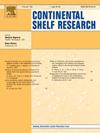Radionuclides and heavy metals in the Kerch Strait sediments: Spatial distribution, fluxes and pollution loads
IF 2.2
3区 地球科学
Q2 OCEANOGRAPHY
引用次数: 0
Abstract
The Kerch Strait is a shipping artery connecting the Black Sea and the Sea of Azov and plays an essential role in the transportation of chemicals between the seas, fishing, socio-economic and tourism activities. The primary factors affecting the strait's ecosystem are construction in the coastal zone (e.g., Crimean Bridge), dredging and soil dumping, port enterprises' operations and shipping. It is known that high concentrations of radionuclides and heavy metals (HMs) are harmful to aquatic organisms and human health due to their persistence, bioaccumulation, acute and chronic toxicity. The study aims to reveal the peculiarities of the spatial distribution of radionuclides (137Cs, 40K, 210Pbex, 226Ra, 232Th) and HMs concentration (Cu, Fe, Cr, Pb, Ni, V, Zn, As, Mn, Ti) in the sediments of the Kerch Strait, assess their sedimentation fluxes, radiological hazard parameters and pollution indices. For this purpose, 12 samples of the surface sediments and four cores were collected in the strait in 2020. The concentration of most radionuclides and HMs in the surface sediments directly correlated with the percentage of mud fraction (r = 0.28–0.90) and TOC (r = 0.41–0.95). The results of Hierarchical cluster analysis and Principal component analysis indicated the presence of two sources of HMs in the surface sediments: geogenic and combined (geogenic + anthropogenic). From the mid-90s to 2020 the sediment and mass accumulation rates increased by a factor of 1.9 and 1.4, respectively. The temporal variability of radionuclides and HMs fluxes into sediments was reconstructed. The sedimentation flux of 137Cs during 1980–1987 was nine times higher than that in 2014–2020. The average sedimentation fluxes of Fe, Zn and Pb during 2014–2020 additionally increased by 31, 21 and 25%, respectively. The radiological hazard parameters indicated no significant health risk to humans from radionuclides and no enrichment/pollution for most HMs. The main exceptions were Cr, Pb and As, for which the geoaccumulation index reached unpolluted to moderately polluted levels while the enrichment factor reached strong, minor and moderate levels, respectively.
刻赤海峡沉积物中的放射性核素和重金属:空间分布、通量和污染负荷
刻赤海峡是连接黑海和亚速海的航运要道,在海洋之间的化学品运输、渔业、社会经济和旅游活动中发挥着重要作用。影响海峡生态系统的主要因素是海岸带的建设(如克里米亚大桥)、疏浚和倾倒土壤、港口企业的经营和航运。众所周知,高浓度的放射性核素和重金属因其持久性、生物蓄积性、急性和慢性毒性而对水生生物和人类健康有害。本研究旨在揭示刻赤海峡沉积物中放射性核素(137Cs、40K、210Pbex、226Ra、232Th)和HMs (Cu、Fe、Cr、Pb、Ni、V、Zn、As、Mn、Ti)的空间分布特征,评价其沉降通量、辐射危害参数和污染指标。为此,2020年在海峡收集了12个表层沉积物样本和4个岩心样本。表层沉积物中大部分放射性核素和hm的浓度与泥组分百分比(r = 0.28 ~ 0.90)和TOC (r = 0.41 ~ 0.95)直接相关。层次聚类分析和主成分分析结果表明,表层沉积物中存在两种有机质来源:地质成因和地质+人为综合来源。90年代中期至2020年,泥沙累积率和质量累积率分别增加了1.9倍和1.4倍。重建了沉积物中放射性核素和hm通量的时间变异性。1980—1987年137Cs的沉降通量比2014—2020年增加了9倍。2014-2020年,铁、锌和铅的平均沉降通量分别增加了31%、21%和25%。放射性危害参数表明,放射性核素对人类没有显著的健康风险,大多数放射性物质没有富集/污染。Cr、Pb和As的地聚集指数分别达到了未污染到中等污染水平,富集系数分别达到了强、弱和中等水平。
本文章由计算机程序翻译,如有差异,请以英文原文为准。
求助全文
约1分钟内获得全文
求助全文
来源期刊

Continental Shelf Research
地学-海洋学
CiteScore
4.30
自引率
4.30%
发文量
136
审稿时长
6.1 months
期刊介绍:
Continental Shelf Research publishes articles dealing with the biological, chemical, geological and physical oceanography of the shallow marine environment, from coastal and estuarine waters out to the shelf break. The continental shelf is a critical environment within the land-ocean continuum, and many processes, functions and problems in the continental shelf are driven by terrestrial inputs transported through the rivers and estuaries to the coastal and continental shelf areas. Manuscripts that deal with these topics must make a clear link to the continental shelf. Examples of research areas include:
Physical sedimentology and geomorphology
Geochemistry of the coastal ocean (inorganic and organic)
Marine environment and anthropogenic effects
Interaction of physical dynamics with natural and manmade shoreline features
Benthic, phytoplankton and zooplankton ecology
Coastal water and sediment quality, and ecosystem health
Benthic-pelagic coupling (physical and biogeochemical)
Interactions between physical dynamics (waves, currents, mixing, etc.) and biogeochemical cycles
Estuarine, coastal and shelf sea modelling and process studies.
 求助内容:
求助内容: 应助结果提醒方式:
应助结果提醒方式:


